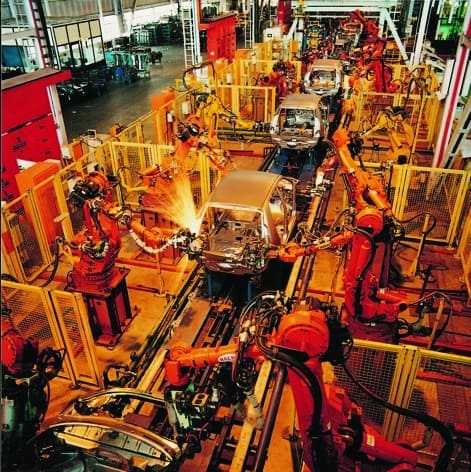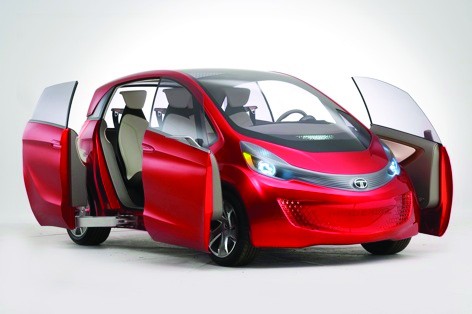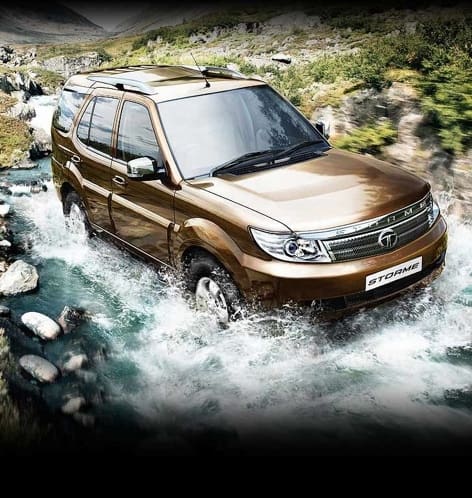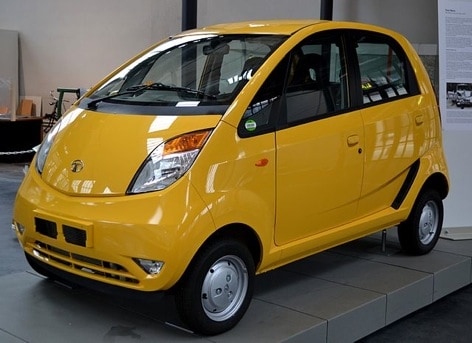A couple of hours’ drive from the roiling, horn-blaring chaos of Mumbai, Tata Motors’ manufacturing site at Pune sprawls over such a large area that the only way to tour its many workshops, production lines and testing facilities is in a kind of open-topped taxi. And if the journey between the two cities demonstrates the ubiquity of Tata in India — its logo emblazoned across the majority of trucks and buses, many taxis and cars, and peeking from the corners of billboards advertising everything from financial services and hotels to watches and jewellery — then the scale the Pune plant and the sheer number and variety of passenger and commercial vehicles inching their way around the production lines shows that this isn’t a company that’s satisfied to stand still.

But although Tata is synonymous with Indian industry, its international credentials are also strong. Its presence in the UK dates well back into the 19th century and it is now, by some measures, the biggest overseas investor in the country, owning Corus — the former British Steel, Jaguar Landrover and Tetley tea (the second-largest tea brand in the country, surely enough to embed it deeply into the national psyche), as well as businesses such as Tata Chemicals in the northeast. And although Tata Motors’ bosses are adamant that the commercial vehicles and company-badged passenger models such as the Indica, the Indica and the Nano — the world’s cheapest production car — are strictly for its home market and for regions such as Southeast Asia, Africa and South America, they still choose to locate the R&D for Tata Motors in the UK, the home of its premium automotive brands.

‘We have an international network of R&D, including engineers at the Warwick Manufacturing Group and a design studio in Turin,’ said Nick Fell, director of the Tata Motors European Technical Centre. ‘In general, we do the early-stage development in the UK, as well as overseeing overall R&D from there.’ For example, he said, the Nano Pixel concept vehicle, a small-turning circle, regenerative braking-equipped city car based on a version of the Nano upgraded to EU safety and emission standards, was originated at Warwick, with design and concept developed there, with the final concept vehicle exhibited at the Geneva Motor Show built by a specialist firm in Frankfurt.
The Tata R&D effort is separate from Jaguar Landrover’s R&D, said Fell; the decision was taken to base Tata R&D in the UK was taken because ‘it has world-class automotive engineers; it was just the best place for us to find the expertise that we need’. There’s no intention to subsume JLR research into Tata Motors, he added: maintaining separation between various group business is an important tenet of Tata’s corporate philosophy.
Nonetheless, there is significant common ground between JLR and Tata Motors R&D efforts, despite their very different products, said Tim Leverton, head of advanced engineering and product development for Tata Motors. Where it’s appropriate, knowledge and development from one side can inform the other, even if teams aren’t working in concert.
‘There’s a common imperative for emissions reductions, although that’s expressed in different ways,’ Leverton said. For India, for example, emissions reduction is driven by the growth of the market: as more people’s income increases to the point where they can afford cars, and Tata continues to develop the Nano low-cost platform so that families who could previously only afford motorbikes can buy a safer, enclosed four-wheeled vehicle, the challenge is to ensure that the increasing number of cars on the road doesn’t further reduce air quality. Although Tata is working on engines with higher power density, more efficient combustion and fewer cylinders, the imperative to fine-tune engines isn’t as pressing for the Indian and South Asian markets; in India, for example, fuel quality is significantly lower, so some technical innovations used in more developed markets would not be practical. ‘The power density, for example, is very different in a Tata engine compared with a JLR engine,’ he added. Moreover, environmental regulations for CO2 and particulates in India are generally five years or so behind Europe’s, Fell added (a fact that can readily be appreciated by trying to take a deep breath in Mumbai).
But where there is common ground is in lightweighting. While Tata hasn’t gone as far as JLR and shifted its production from steel to aluminium, use of high-strength steels and redesigning chassis so that they can be built with less material without compromising strength have all helped Tata reduce vehicle weight; for example, the latest range of medium commercial vehicles is five to 10 per cent lighter than its predecessor, and the company has developed a 1.05-litre three-cylinder engine, which has the same performance as a 1.4-litre, four-cylinder.

Other innovations have involved ancillary systems such as compressors and pumps, with a control system that ensures that they only consume power when the operation of the vehicle demands it. ‘In general, developments in systems and components can be shared between Tata and JLR,’ Leverton said. ‘We’ve also brought the engineering standards and design rules from JLR over to Tata.’
Like the rest of the Tata Group, Tata Motors is setting into motion a business plan to take it up to 2020. ‘We’re looking at expanding in many markets all around the world,’ said managing director Karl Slym. ‘In fact, North America is the only region outside the scope of our 2020 horizon.’ Eastern Europe is a target market, he said, notably for commercial vehicles; the company is also considering expanding its defence vehicles business, which builds mine-protected vehicles and currently supplies the Indian army along with markets in South and Southeast Asia.

”North America is the only region outside the scope of our 2020 horizonKarl Slym, Tata Motors managing director
This is, in part, a response to falling sales in both the commercial and passenger vehicle markets, he explained, as the global recession bites — somewhat later than it did in Europe, but still a cause for concern. ‘We maintain a 68 per cent market share of the medium and heavy vehicles markets, but we’re doing that selling half as many actual vehicles as we were five years ago,’ Slym said.
Despite this, the company still has no plans to start selling its low-cost Nano car in more developed markets. Recently relaunched with slightly less basic features in response to customer demand — glove boxes and Bluetooth connectivity are now available — and an altered purchase plan to take account of the large number of Indians who live in rural areas and don’t have bank accounts, the Nano in its current form does not meet European standards for emissions or safety. Bringing it up to a standard for the European market would increase the cost and erode any advantage price advantage the Nano would have over other small, basic cars, Fell said.
JLR, meanwhile, is proving a shrewd investment for Tata, despite initial cynicism from local analysts who thought it was a ‘dodgy’ acquisition compared with Corus, which it had bought some months previously, according to Tata Group chief ethics officer Mukund Rajan. It has allowed the company to enhance its presence in the developed world without having to develop new models for Tata Motors. ‘One of the main attractions of JLR was the strength of its product pipeline,’ Rajan said. ‘We have no desire to change the relationship of the company to its customers, so we have absolutely to plans to change the branding or to add the Tata name to the brand.’
The company has now launched 19 JLR showrooms in 17 Indian cities, with the first, in Mumbai itself, selling the products of both parts of the company and with décor split neatly down the middle: leather-covered columns and polished wood-panelled sales suites for Jaguar to the left, stainless steel and chunky fittings for Land Rover to the right. Sales are roughly 50:50 between the two, with about 2,000 units sold last year and a target of 3,000 for 2013–14.
Manufactured imports to India attract heavy taxation, which is based on the number of people who would have been employed to make the item locally. To reduce the tax on two JLR models — the Jaguar XF and Land Rover Freelander — are assembled from flatpacks in Pune (the flatpacks attract import taxes as well, but much less than a complete car). The Freelander isn’t the biggest seller, however: as with elsewhere in the world, that honour goes to the Range Rover Evoque, which Tata Motors executives confirmed could also be assembled at Pune (and might be in future).
Most Indian JLR customers are new to the luxury car market: many are small business owners looking for a high-status purchase. The cachet of owning a car built in the UK — similar to that attached to a product such as a Savile Row suit — means that, for many, high taxes aren’t a disincentive to purchase.

The JLR influence is particularly noticeable in Tata Motors’ own SUV model, the Safari Storme. Recently redesigned with a stronger, lighter hydroformed chassis, the Safari clearly takes design cues from Land Rover with its squared-off front end designed to be entirely visible from the driving position; from Range Rover with its array of stowable seating, and from JLR in general with the haptics of the controls and switchgear.
Afterword: This article was written and published before the sad passing of Karl Slym. The Engineer would like to extend its condolences to Mr Slym’s family and colleagues.
Paying dues
Tata is conscious of its own history and its debt to wider society
On a three-day visit with other UK journalists to see Tata Group’s activities in India, two factors come across clearly: Tata is a company that clearly believes in the power of engineering, both on a large and small scale, to improve people’s lives, and also believes that industry — in fact, commerce in general — owes a debt to the society in which it exists.
It also has a very keen sense of history. Wherever you go within the Tata empire, you’re watched over by busts, statues and paintings of its founder, Jamshetji Tata, whose 175th anniversary the company will celebrate this year, gazing out with an expression that seems to combine shrewdness and benevolence between a luxuriant beard and a conical Parsee hat; and the company’s longest-serving chairman, the Indo-French JRD Tata, sharp-suited and with a matinée idol’s pencil moustache, who ran the company for 50 years from 1938. Both wrote themselves into India’s history in different ways: Jamshetji lent his name to the centre of India’s steel industry, Jamshedpur, while RJD’s lifelong obsession with flying (his boyhood home was next door to Louis Blériot, and he obtained India’s first pilot’s licence) led to him starting the airline that became Air India.
 Jamshetji’s sons, who began the company’s engagement with charities, funded causes including Ghandi’s early anti-apartheid campaigns in South Africa. Charity still runs deep with Tata: two-thirds of the company is owned by charitable trusts, which give away their income every year, funding a range of causes including education and health: India’s two leading cancer research centres are Tata-funded.
Jamshetji’s sons, who began the company’s engagement with charities, funded causes including Ghandi’s early anti-apartheid campaigns in South Africa. Charity still runs deep with Tata: two-thirds of the company is owned by charitable trusts, which give away their income every year, funding a range of causes including education and health: India’s two leading cancer research centres are Tata-funded.
The company’s connection with the UK also goes back a long way — to Jamshetji himself, who, while working for his father’s textiles trading company, visited the Lancashire cotton mills in the early 1860s. Excited by the potential of engineering and technology to revolutionise textile manufacturing but appalled by the working conditions he encountered, on his return to India he founded his own cotton mill not far from Bombay, and instituted improved working conditions such as eight-hour working days, proper ventilation, and guaranteed pensions for workers well in advance of British mills.
When Jamshetji died in 1904, Tata was involved in hotels, textiles and hydroelectric power; it was JRD who expanded it to the company that exists today, founding Tata Motors, Tata Tea, Tata Consultancy Services. He maintained the company’s political neutrality — it still does not contribute to any political party — and founded Asia’s first cancer hospital.
It’s striking that a company the size of Tata has displayed such strong links with the community for so long and it’s difficult to think of any Western equivalent. There are perhaps parallels with the Quaker industrialists of the late 19th century, such as Bournville and Titus Salt, and with Lever Brothers, who built villages and schools for their employees; although Tata seems to have been less dogmatically religious.
Moreover, Tata has embedded helping the community into its business practices from its inception. Its business plan revolves around developing products for the largest possible market, which in India means people without much money, hence the Tata Nano (above), the world’s cheapest production car, developed to allow people who could previously only afford motorbikes to buy a car to hold their entire family.




Red Bull makes hydrogen fuel cell play with AVL
Formula 1 is an anachronistic anomaly where its only cutting edge is in engine development. The rules prohibit any real innovation and there would be...